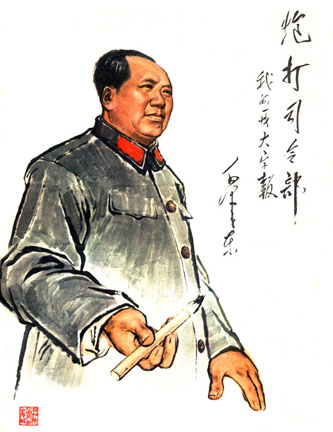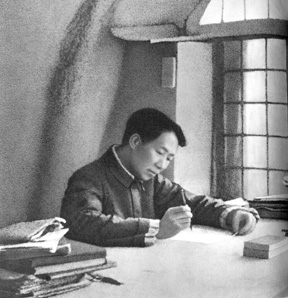


Calligraphy has remained a potent force in Chinese life up to the present. During the Song, Yuan, Ming, and Qing dynasties, calligraphy continued to be a central art of the literati, closely associated both with painting and with the social and cultural life of the educated elite. The Chinese landscape came to reflect the appreciation of calligraphy, as stones inscribed with the calligraphy of admired artists were erected at famous sites. Calligraphy could also be seen on temple name plaques, on shop signs, and on couplets pasted by the doors of even very modest homes. Calligraphy, thus, formed an ever-present part of China's visual culture.
|
||||||||||||||||||||||
|
Painting of Mao Zedong wielding the brush to write the "large character poster" that launched the cultural revolution: "Bombard the Headquarters"
|
||||||||||||||||||||||
| During the twentieth century, the social and political uses of calligraphy have been radically changed. Calligraphy is no longer an art associated primarily with the traditional scholarly elite. Not only has calligraphy been employed as a tool of revolution, but it has become a popular amateur art practiced by people of all walks of life, and artists have found ways to use it to challenge traditions rather than perpetuate them. | ||||||||||||||||||||||

Under Mao, words were frequently seen on the street displayed on banners or signs with revolutionary slogans. Most of the time, the style used for revolutionary slogans was bold and block-like, with no resemblance to calligraphy produced through use of the brush.
At workplaces, as seen below, prominent signs urged workers to sustain their revolutionary ardor. How do you think the common sight of slogans like these would shape how people looked on calligraphy done with a brush? |
||||||||||||||||||||||
|
||||||||||||||||||||||
|
 |
|||||||||||||||||||||
|
Workshop decorated with banner proclaiming "Under no conditions forget class struggle!"
|
||||||||||||||||||||||
|
The characters on the wall of the Kirin Municipal Oil and Grease Plant urge "arduous struggle" in 1970
|
||||||||||||||||||||||
|
Even if block-like calligraphy had revolutionary overtones, Mao and other leading revolutionaries wrote in styles much closer to traditional calligraphy. Moreover, even after most people took up writing with pencils and ball-point pens, leading party members continued to do calligraphy with traditional brushes. They would give away pieces of their calligraphy and allowed their calligraphy to be widely displayed. |
||||||||||||||||||||||
|
Mao was not only a calligrapher, but also a poet. Below is the first part of a poem he wrote in response to a poem sent to him by the literary figure, Guo Moruo. The poem extols revolutionary action, but uses traditional poetic forms.
|
||||||||||||||||||||||
|
||||||||||||||||||||||
|
For other political leaders' calligraphy, click here [given below in this Teacher's Guide].
|
||||||||||||||||||||||
|
|
||||||||||||||||||||||
|
||||||||||||||||||||||
|
Leaders, beginning with Mao, but continuing to the present, liked to be photographed doing calligraphy or making gifts of it. |
||||||||||||||||||||||
 |
 |
|||||||||||||||||||||
|
Mao writing in the 1940s
|
|
|||||||||||||||||||||

In 2001 China's premier Jiang Zemin had himself photographed conferring an inscription in his own calligraphy to a society he wanted to support. What do you think a political leader has to gain from publication of a picture like this? |
||||||||||||||||||||||
|
||||||||||||||||||||||

One also can still see calligraphy by earlier political leaders in China today. This inscription proclaiming the Confucian virtue of broad love is in the hand of Sun Yat-sen. |
||||||||||||||||||||||
|
Inscription by Sun Yat-sen in Shanxi province
|
||||||||||||||||||||||
|
There is still work today for calligraphers and a substantial market for calligraphy scrolls produced in the traditional manner. Many art schools now have professors of calligraphy training calligrapher-artists. Considerably less well paid are calligraphers who produce calligraphy for signs and door frames. Nevertheless, this sort of calligraphy continues to form a significant part of everyday visual culture. |
||||||||||||||||||||||

The entrance to this house has not only the character for "blessings" cut into the brick (visible behind the bicycle) and a four character phrase above the entrance but also two temporary paper strips on either side of the door. The phrase across the top reads "auspicious stars shine on high." The paper strip hanging down the right side reads "The two characters 'peace' and 'calm' are worth a thousand in gold." The one on the left reads "When harmony and obedience fill the home it adds a hundred blessings." Do you think whoever put up these characters cared about their calligraphy? If the auspicious meanings were legibly represented, would that have been enough? |
||||||||||||||||||||||
|
Doorway, Shanxi province, 2001
|
||||||||||||||||||||||

Stores, of course, also have signs announcing their names and products. Do some of the characters on these store signs seem more calligraphic than others? What makes them different? |
||||||||||||||||||||||
|
||||||||||||||||||||||
|
Calligraphy today is practiced by millions of Chinese. The great majority of practitioners are amateurs, who find pleasure or artistic fulfillment in perfecting their script. But the number of professional calligraphers or calligrapher-artists is also substantial. Move on to Calligraphy as an Amateur Art |